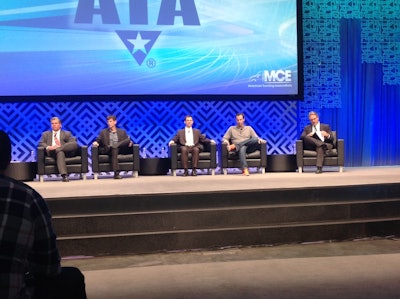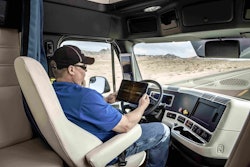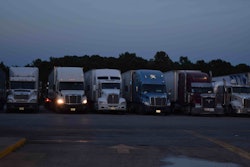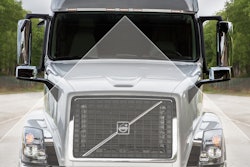
In contrast to other presenters in suits and ties, Anthony Levandowski came dressed in bright orange sneakers, jeans and a quarter-zip pullover. Make no mistake, he is very serious about the future of trucking, however.
“I love robots,” said the former Google executive and co-founder of Otto. Levandowski started building self-driving trucks from his garage in Palo Alto, Calif., in early 2016. Otto was recently acquired by Uber and he now lead’s Uber’s self-driving efforts for cars and trucks.
The future of transportation and trucking is liquidity and automation, he said. Liquidity is the ability to match carriers and shippers efficiently to reduce empty loads and emissions. Automation means having self-driving trucks everywhere, all the time.
Just as the passenger ride service Uber began to offer last-mile delivery of take-out food and groceries, Uber Freight will be delivering truckload-size quantities. At some not-too-distant point, those deliveries will be made with self-driving trucks.
Uber has launched 14 self-driving cars in Pittsburg that are now undergoing tests.
“We are pushing for technology to grow and be better than the best driver,” he said. “Once we have a vehicle that can drive better than best driver, we want to put that driver on everything, including trucking.”
To put the crowd at ease, he said technology gets cheaper over time and “makes lives better.” As an example, he spoke of the technology that replaced elevator operators to safely stop passengers at the right spots in buildings.
“Up until now we haven’t had the right technology for seeing the world, digitizing it in 3D, and understanding where should the truck stop or should the truck drive around,” he said.
Contrary to popular belief, he predicted driverless trucks will be less expensive than today’s equipment since 30 to 40 percent of their cost is for driver comfort and amenities like sleepers and air conditioning.
He also made a case for self-driving trucks being safer and more productive by citing research that approximately one in four drivers have a safety-critical event when driving in the 11th hour.
Uber is in the process of launching the Uber Freight marketplace for finding backhaul jobs. This will be a precursor to self-driving trucks. Those interested in participating in the marketplace and the future of technology can visit https://testdrive.ot.to/, he said.
On the topic of truck platooning — where technology automatically keeps two trucks in close proximity on the highway to improve fuel economy — all panelists agreed the future is promising and near.
Trucking industry journalist Jack Roberts discussed a new report he authored for the North American Council on Freight Efficiency. The report found platooning has a fuel efficiency benefit of between four and 10 percent for trucks. The trailing vehicle benefits the most.
The panel agreed driverless trucks are coming, but the timeframe is a bit murky.
“The future of autonomous vehicles as far as we can see into the future is still with the driver in control of the vehicle,” said Shaun Waters, director of compliance and regulatory affairs for Daimler Trucks North America. “There are frankly lots of decisions we need to make.”
The technology for autonomous trucks has been demonstrated with the Freightliner Inspiration truck. This project has created a new dialogue about the necessary regulations and legal issues that need to be ironed out before driverless trucks become reality.













